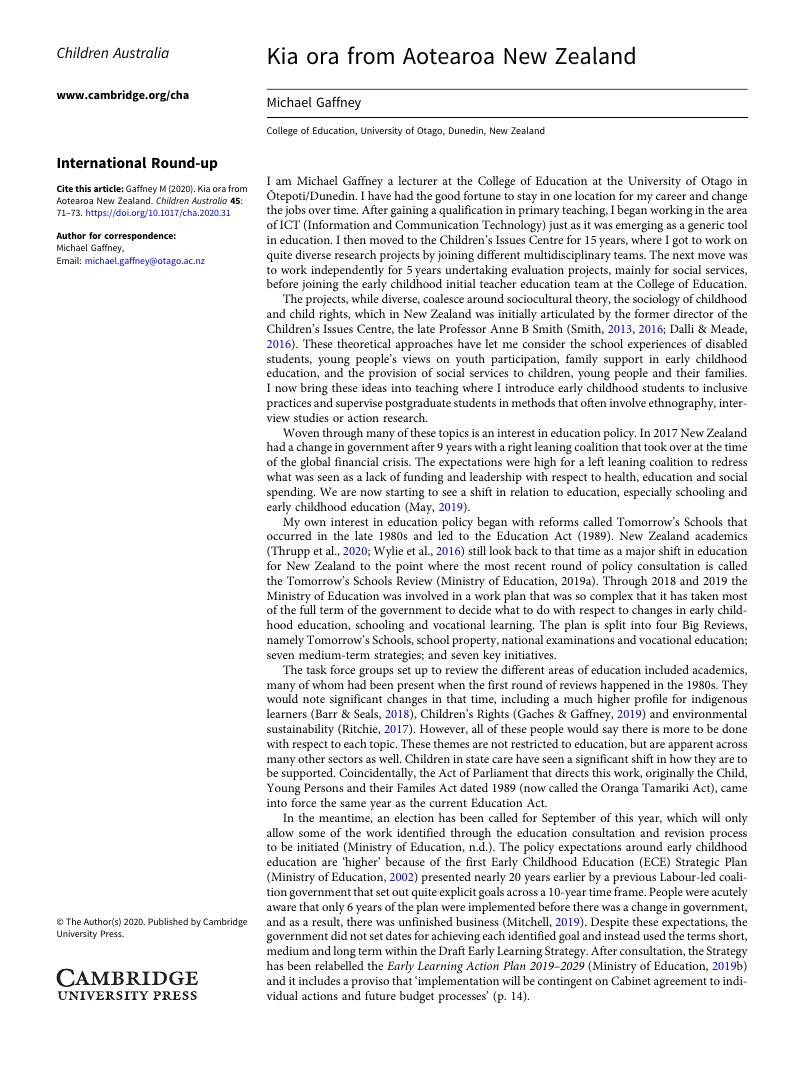No CrossRef data available.
Article contents
Kia ora from Aotearoa New Zealand
Published online by Cambridge University Press: 19 August 2020
Abstract
An abstract is not available for this content so a preview has been provided. Please use the Get access link above for information on how to access this content.

- Type
- International Round-up
- Information
- Copyright
- © The Author(s) 2020. Published by Cambridge University Press
References
Barr, S., & Seals, C.A. (2018). He reo for our future: Te reo Māori and teacher identities, attitudes, and micro-policies in mainstream New Zealand schools. Journal of Language, Identity & Education, 17(6), 434–447, doi: 10.1080/15348458.2018.1505517CrossRefGoogle Scholar
Babaian, J. (2020, April 7). The pandemics 4th wave. HCLDR. https://hcldr.wordpress.com/2020/04/07/the-pandemics-4th-wave/Google Scholar
Dalli, C., & Meade, A. (Eds.). (2016). Research, policy and advocacy in the early years: Writing inspired by the achievements of professor Anne Smith. New Zealand Council for Educational Research.Google Scholar
Gaches, S., & Gaffney, M. (2019). Children’s rights and the draft Strategic Plan for Early Learning: Where are the children? Early Childhood Folio, 23(1), 1–6. doi: 10.18296/ecf.0064CrossRefGoogle Scholar
May, H. (2019). Politics in the playground: The world of early childhood education in Aotearoa New Zealand (3rd ed.). Otago University Press.Google Scholar
Ministry of Education. (n.d.). Kōrero Mātauranga/Education conversation. Government Printer. https://conversation.education.govt.nz/out-and-about/Google Scholar
Ministry of Education. (2002). Pathways to the future: Ngā hurarahi arataki. A 10 year strategic plan for early childhood educationGoogle Scholar
Ministry of Education. (2019a). Supporting all schools to succeed: Reform of the Tomorrow’s Schools system. https://conversation.education.govt.nzGoogle Scholar
Ministry of Education. (2019b). He Taonga te tamaiti: Every child a taonga. Early learning action plan 2019–2029. https://conversation.education.govt.nzGoogle Scholar
Mitchell, L. (2019). Democratic policies and practices in early childhood education, international perspectives on early childhood education and development (Vol. 24). Springer. doi: 10.1007/978-981-13-1793-4_1CrossRefGoogle Scholar
McTague, T. (2020, May 18). The pandemic’s geopolitical aftershocks are coming. The Atlantic. https://www.theatlantic.com/international/archive/2020/05/coronavirus-pandemic-second-wave-geopolitics-instability/611668/Google Scholar
NZ Treasury. (2020). The wellbeing budget 2020: Rebuilding together. New Zealand Government. https://treasury.govt.nz/publications/wellbeing-budget/wellbeing-budget-2020Google Scholar
Quinlivan, M. (2020, May 23). Second political poll spells trouble for Simon Bridges as Jacinda Ardern’s popularity skyrockets. Newshub. https://www.newshub.co.nz/Google Scholar
Ritchie, J. (2017). Fostering Eco-cultural literacies for social, cultural and ecological justice: A perspective from Aotearoa (New Zealand). International Journal of Early Childhood, 49(3), 287–302. doi: 10.1007/s13158-017-0198-0CrossRefGoogle Scholar
Robertson, G. (2020). Budget speech. Wellbeing budget 2020: Rebuilding together. New Zealand Government.Google Scholar
Smith, A. B. (2013). Understanding children and childhood (5th ed.). Bridget Williams.Google ScholarPubMed
Thrupp, M., O’Neill, J., Powell, D. & Butler, P. (2020): Private actors in New Zealand schooling: The path to saturation. Journal of Educational Administration and History [online], doi: 10.1080/00220620.2020.1726882CrossRefGoogle Scholar
Wylie, C., Cosslett, G., & Burgon, J. (2016). New Zealand principals: Autonomy at a cost. In Ärlestig, H., Day, C., & Johansson, O. (Eds.), A decade of research on school principals. Studies in Educational Leadership (Vol. 21). Springer. doi: 10.1007/978-3-319-23027-6_13Google Scholar


